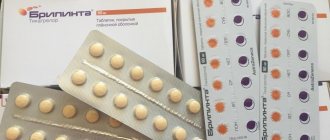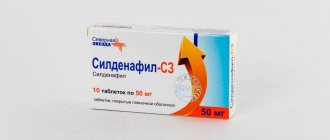Description of the drug CLOPIDOGREL
When treating with clopidogrel, especially during the first weeks of treatment and/or after invasive cardiac procedures/surgery, patients must be carefully monitored to exclude signs of bleeding, incl. hidden.
Due to the risk of bleeding and adverse events from the hematopoietic system, if clinical symptoms suspicious for bleeding appear during treatment, you should urgently do a general clinical blood test, determine the activated partial thromboplastin time (aPTT), platelet count, and indicators of functional activity platelets and conduct other necessary studies.
Clopidogrel, like other antiplatelet agents, should be used with caution in patients who have an increased risk of bleeding associated with trauma, surgery or other pathological conditions, as well as in patients taking ASA, NSAIDs, incl. COX-2 inhibitors, heparin or glycoprotein IIb/IIIa inhibitors.
If the patient is undergoing elective surgery, and there is no need for an antiplatelet effect, then clopidogrel should be discontinued 5-7 days before surgery.
Clopidogrel prolongs bleeding time and should be used with caution in patients with diseases predisposing to the development of bleeding (especially gastrointestinal and intraocular). Medicines that can cause damage to the gastrointestinal mucosa (such as ASA, NSAIDs) should be used with caution in patients taking clopidogrel.
Patients should be warned that when taking clopidogrel (as monotherapy or in combination with ASA), bleeding may take longer to stop and that if they experience unusual bleeding (in location or duration), they should tell their healthcare provider. Before any upcoming surgery and before starting any new drug, patients should tell their doctor (including their dentist) that they are taking clopidogrel.
Very rarely, after the use of clopidogrel (sometimes even for short periods), there have been cases of the development of thrombotic thrombocytopenic purpura (TTP), which is characterized by thrombocytopenia and microangiopathic hemolytic anemia, accompanied by neurological disorders, renal dysfunction and fever. TTP is a potentially life-threatening condition that requires immediate treatment, including plasmapheresis.
In patients with recent transient cerebrovascular accident or stroke who are at high risk of developing recurrent ischemic complications, the combination of ASA and clopidogrel has been shown to increase the incidence of major bleeding. Therefore, such combination therapy should be carried out with caution and only in case of proven clinical benefit from its use.
Cases of acquired hemophilia have been reported when taking clopidogrel. With a confirmed isolated increase in aPTT, accompanied or not accompanied by the development of bleeding, the possibility of developing acquired hemophilia should be considered. Patients with a confirmed diagnosis of acquired hemophilia should be observed and treated by specialists in this disease and stop taking clopidogrel.
In patients with low activity of the CYP2C19 isoenzyme, when clopidogrel is used in recommended doses, less of the active metabolite of clopidogrel is formed and its antiplatelet effect is less pronounced, and therefore, when taking the usually recommended doses of clopidogrel in acute coronary syndrome or percutaneous coronary intervention, a higher incidence of cardiovascular disease is possible. vascular complications than in patients with normal activity of the CYP2C19 isoenzyme.
Patients should be assessed for previous allergic and/or hematological reactions to other thienopyridines (such as ticlopidine, prasugrel), as cross-allergic and/or hematological reactions between thienopyridines have been reported. Patients who have previously experienced allergic and/or hematological reactions to one of the drugs in the thienopyridine group may have an increased risk of developing similar reactions to another drug in this group. Monitoring for cross-allergic and/or hematological reactions is recommended.
During the treatment period, it is necessary to monitor the functional state of the liver. In case of severe liver damage, the risk of developing hemorrhagic diathesis should be kept in mind.
Taking clopidogrel is not recommended for acute stroke less than 7 days old (as there is no data on its use in this condition).
Clopidogrel, 75 mg, film-coated tablets, 14 pcs.
During the treatment period, it is necessary to monitor indicators of the hemostatic system (activated partial thromboplastin time (aPTT), platelet count, platelet functional activity tests); regularly examine the functional activity of the liver.
Clopidogrel should be used with caution in patients at risk of significant bleeding due to trauma, surgery, in patients with injuries prone to bleeding (especially gastrointestinal and intraocular), as well as in patients receiving ASA, non-steroidal anti-inflammatory drugs (including including COX-2 inhibitors), heparin or glycoprotein IIb/IIIa inhibitors. Patients should be closely monitored for any signs of bleeding, including occult bleeding, especially during the first weeks of drug use and/or after invasive cardiac procedures or surgery. The simultaneous use of clopidogrel and warfarin is not recommended, as it may increase bleeding.
In the case of surgical interventions, if the antiplatelet effect is undesirable, the course of treatment should be discontinued 7 days before surgery.
Patients should be warned that since stopping bleeding occurring during the use of clopidogrel (in combination with or without ASA) requires more time, they should report each case of bleeding to the doctor. Patients should also inform the doctor about taking the drug if they are undergoing surgery.
Thrombotic thrombocytopenic purpura (TTP) has been reported very rarely after taking clopidogrel, sometimes after short-term use. This condition is characterized by thrombocytopenia and microangiopathic hemolytic anemia in combination with neurological signs, renal dysfunction or fever. TTP is a potentially fatal condition that requires immediate treatment, including plasmapheresis.
Due to lack of data, clopidogrel cannot be recommended for acute (less than 7 days) ischemic strokes.
Experience with the use of clopidogrel in patients with impaired renal function is limited, so clopidogrel should be prescribed to these patients with caution.
In case of severe liver dysfunction, the risk of developing hemorrhagic diathesis should be remembered; experience with the drug in patients with moderate liver dysfunction is limited, so clopidogrel should be prescribed to these patients with caution.
Ability to drive vehicles.
Clopidogrel may cause side effects from the nervous system (headache, dizziness, systemic dizziness, confusion, hallucinations), which may affect the ability to drive vehicles and engage in other potentially hazardous activities that require increased concentration and speed of psychomotor reactions.
Instructions for use of Clopidogrel and overdose
The dosage and other rules of administration are determined by the doctor. The product is taken 1 pc. every day - before, during or after meals. First, the daily amount is determined at 75 mg, then it can be increased, with the limit value being 300 mg per day.
The prescribed dosage must be carefully observed. Violation of the specified amount can lead to bleeding and other complications. In this case, symptomatic treatment is carried out. You may need emergency help. If the condition is severe, platelet mass is administered to the patient in a clinical setting.
Tablets "Clopidogrel" description
The product is available in the form of tablets, which contain the active ingredient of the same name in the form of sulfate (75 mg per piece). It is also called clopidogrel. Additional substances - silicon dioxide, lactose in the form of monohydrate and others. Tablets are produced in different packages of 7, 10, 14 or 28 pieces.
The drug has an antiplatelet effect. The active component prevents platelets from sticking together. Clopidogrel is quickly absorbed from the intestine. Excreted in feces and urine in a ratio of approximately 1:1. Half the dose is eliminated within 8 hours.
The product is stored under normal room conditions at temperatures up to 25 degrees. The place should be dark, the humidity should be moderate. Access for children is prohibited. The general shelf life is 3 years from the date of production.
Drug interactions
The medicine is not recommended for use in combination with non-steroidal anti-inflammatory drugs. In this case, the risk of bleeding in the abdominal cavity (gastrointestinal tract) increases.
Another limitation is combined use with medications containing acetylsalicylic acid. Then the antiplatelet effect is enhanced, so the dosage of Clopidogrel should be reduced - otherwise the risk of bleeding also remains.
If you combine the drug with Phenytonin and other similar drugs, the concentration of the latter in the blood may increase.
special instructions
If the patient regularly takes non-steroidal anti-inflammatory drugs or acetylsalicylic acid, he needs to tell his doctor about this in advance. In this case, the course of therapy can be adjusted, including temporarily stopping any medications or reducing their dosage.
If disorders such as hematuria, menorrhagia, and bleeding gums are diagnosed, a coagulogram (special diagnostic test) is indicated. During treatment, it is recommended to monitor liver parameters by taking appropriate tests.
"Clopidogrel" is used with caution in case of threat of bleeding due to injury or recent intervention, as well as in the presence of severe liver disease.
The effect of the drug on performance, reaction, concentration has not been identified. Therefore, it is allowed to be accepted by drivers, machine operators and other moving mechanisms.
Side effects
Side effects are not observed so often. The following manifestations are possible:
- feverish condition;
- exacerbation of ulcers;
- constipation;
- digestive disorders;
- feeling of nausea;
- liver failure;
- colitis;
- stomatitis;
- pancreatitis;
- development of bleeding;
- leukopenia;
- anemia;
- hemorrhages in the tissue of the eye organ;
- headaches;
- confusion;
- intracranial hemorrhage;
- the appearance of hallucinations;
- bronchospasms;
- nosebleeds, pulmonary bleeding;
- decreased blood pressure;
- the appearance of allergic reactions;
- arthritis;
- arthralgia;
- rashes, dermatitis;
- myalgia;
- eczema;
- hematuria;
- increase in creatine concentration.
Indications and contraindications
The drug is prescribed by a doctor to prevent blood clots. This is especially true for patients with the following pathologies:
- ischemic stroke;
- myocardial infarction;
- acute coronary syndrome;
- narrowing of the width of the lumen of the arteries;
- atrial fibrillation with complications;
- impossibility of using drugs related to indirect coagulants.
There are not many contraindications. The use of the drug is excluded in the following situations:
- severe liver dysfunction;
- hypersensitivity to the active or auxiliary components, the appearance of allergic reactions;
- all stages of pregnancy;
- breastfeeding period;
- acute bleeding;
- children up to 17 years old inclusive.

